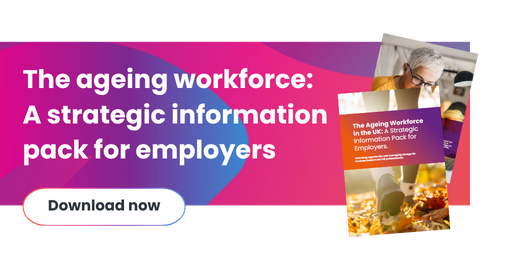You’re only as old as you feel!
We’ve all heard the phrase, and for many older workers, it’s certainly true.
With the right policies and workplace practices, employers can harness the skills and experience of older workers, while supporting their wellbeing and continued productivity. Addressing these demographic changes is essential for sustaining economic growth and social cohesion in the coming decades.
With energy, passion and years of experience, they’re still continuing to be a part of company innovation and helping to deliver success. But while mindsets matter, the ageing workforce in the UK presents both challenges and opportunities.
The growing reality
According to our latest research, 1 in 3 workers in the UK are aged 50 or over, which is more than 10 million workers.
The workforce is ageing and just like rain during a British summer, sadly it’s inevitable. HR professionals across the UK have to face up to that reality. But that reality can also help shape the way we think about employees, wellbeing, and productivity.
With concerns about a change in Pension age and financial uncertainty continuing to be a major talking point, more and more employees are working later into their life. Employers have a unique opportunity to harness the skills, experience, and loyalty of older employees, with these individuals carrying years (if not decades) of insightful knowledge and problem-solving abilities. They’re assets that can be an invaluable resource in today’s ever-changing landscape.
But alongside this opportunity come challenges. Supporting older workers means rethinking traditional approaches to workplace wellbeing, career development, and flexibility. It requires a shift from reactive policies to proactive planning, ensuring that every employee, regardless of age, feels valued, supported, and equipped to thrive.
Below, we dive deeper into ‘The Ageing Workforce in the UK: A Strategic Information Pack for Employers’ exploring the key trends shaping the ageing workforce in the UK, the challenges HR teams face, and some practical steps employers can take to build inclusive, age-positive workplaces in 2026 and beyond.
The key trends
Demographic trends: The UK population is ageing rapidly. There are now over 20 million people aged 60 and above - nearly a third of the population. The number of people aged 65 and over is projected to rise by more than 40% in the next 20 years (reaching over 16 million by 2045).
Workforce age breakdown: The number of workers over 50 has grown by more than 60% over the past two decades. As of 2024, older workers (50+) made up around one third of the UK workforce. By 2030, it’s estimated that half of all adults in the UK will be over the age of 50.
Economic impact: Ageing workers are vital to the UK economy. Over-50s contribute around £88 billion to the UK economy each year. However, early exit from the workforce due to lack of support, health issues, or discrimination costs billions annually in lost productivity and increased welfare spending.
The key challenges
The shrinking labour market:
- Employers face a shrinking pool of younger workers, rising skills shortages, increased health and wellbeing needs, and the risk of losing valuable experience through a ‘brain drain’ as older employees retire early.
- An increasing number of older workers are leaving the workforce before pension age and becoming economically inactive, significantly contributing to higher vacancies and labour shortages.
- More restrictive immigration policies are also contributing to this shrinking labour market.
- The UK government has an aspiration to achieve an overall employment rate of 80% (it’s currently 75%) to plug this labour gap. This can only be achieved by increasing the proportion of ‘older workers’ that are economically active (in work).
- Ignoring the ageing workforce is not an option. The challenge is to adapt - ensuring business continuity, maintaining productivity, and capitalising on the strengths of older workers.
The exodus of over 50's from the labour market
- The UK is unique - no other high-income country has seen a comparable sustained rise in over 50’s becoming, and remaining, economically inactive since the start of the 2020’s.
- Other countries (75% in the Netherlands and Switzerland and 81% in Iceland compared to 65% in the UK) have already achieved an 80% employment rate, but they have a much higher percentage of people aged 55-64 in employment than the UK.
Some practical steps employers can take
Our research found that whilst 38% of all departures are due to either stress or redundancy, a further 33% are linked to ‘not feeling supported I my job’ and ‘wanting a change in lifestyle’.
1. Embrace flexible working
Offer flexible hours, remote options, and phased retirement plans to support older employees’ changing needs while keeping them engaged and productive.
2. Invest in lifelong learning
Provide training and development opportunities for all ages to ensure older workers stay confident, skilled, and future-ready.
3. Prioritise health and wellbeing
Tailor wellbeing programmes to include physical, mental, and financial health support that reflects the needs of an ageing workforce.
4. Encourage intergeneration collaboration
Create opportunities for knowledge-sharing between age groups through mentoring, team projects, and inclusive leadership development.
5. Tackle age bias and celebrate experience
Promote age diversity through inclusive policies, awareness training, and recognition of the unique value older employees bring to the workplace.
Are you a business leader or HR professional looking to unlock opportunity and manage change?
To download 'The Ageing Workforce in the UK: A Strategic Information Pack for Employers' click here.





